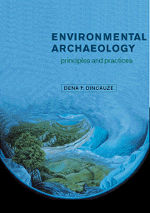Book contents
- Frontmatter
- Contents
- List of figures
- List of tables
- Preface
- Acknowledgments
- Glossary
- PART I INTRODUCTION
- PART II CHRONOLOGY
- PART III CLIMATE
- PART IV GEOMORPHOLOGY
- PART V SEDIMENTS AND SOILS
- 11 BASIC PRINCIPLES OF SEDIMENTOLOGY AND SOILS SCIENCE
- 12 ARCHAEOLOGICAL MATRICES
- Case Study: Did the Classical civilizations destroy their own agricultural lands?
- PART VI VEGETATION
- PART VII FAUNA
- PART VIII INTEGRATION
- References
- Index
12 - ARCHAEOLOGICAL MATRICES
Published online by Cambridge University Press: 20 January 2010
- Frontmatter
- Contents
- List of figures
- List of tables
- Preface
- Acknowledgments
- Glossary
- PART I INTRODUCTION
- PART II CHRONOLOGY
- PART III CLIMATE
- PART IV GEOMORPHOLOGY
- PART V SEDIMENTS AND SOILS
- 11 BASIC PRINCIPLES OF SEDIMENTOLOGY AND SOILS SCIENCE
- 12 ARCHAEOLOGICAL MATRICES
- Case Study: Did the Classical civilizations destroy their own agricultural lands?
- PART VI VEGETATION
- PART VII FAUNA
- PART VIII INTEGRATION
- References
- Index
Summary
The excavator's aim should be to explain the origin of every layer and feature he encounters whether it be structural or natural; made by man, animal or insect, accidental or purposeful.
BARKER 1982: 68Every surface on which humans lay foot or artifact is a potential archaeological site, requiring only that subsequent processes not dislodge and transport the surficial deposits. Of course, disturbance of surficial sediments of every kind is the normal case. This vulnerability ensures that archaeological sites are neither ubiquitous nor permanent.
The focus of this chapter is on sediments and soils as matrices of archaeological sites, at local and micro-scales. We occasionally lift our eyes to regional-scale phenomena, as in considering the information potentials of widespread deposits of loess or volcanic ash, but we pay no attention here to the mega- and macro-scales of phenomena or to regional-scale interpretations.
MESSAGES IN THE MATRIX
Sedimentological analyses are undertaken to learn about the sources, transportation agents, depositional and transformational history of the materials comprising deposits (Chapter 11). Although archaeologists typically treat that information as background, environmental archaeology must begin with the environments in which materials, whether cultural or natural sedimentary particles, were brought to a site, deposited, and affected by postdepositional processes including pedogenesis and diagenesis. The enclosing matrix is the fundamental source of information about all the processes essential to understanding the context of human behavior at a site. Not all evidence is visible, and not all is extractable by techniques currently known. However, for sites lacking written evidence the matrix is the only source of non-artifactual information; for sites with written histories, the matrix will variously confirm, expand, or contradict elements of that record.
- Type
- Chapter
- Information
- Environmental ArchaeologyPrinciples and Practice, pp. 291 - 319Publisher: Cambridge University PressPrint publication year: 2000

